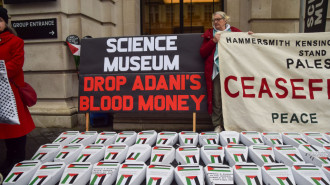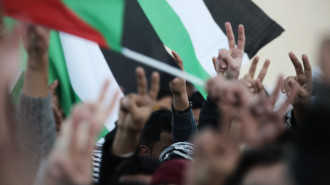
From military coups to assassinations: The tumultuous history of Pakistan's prime ministers who never made it to the finish line

Since 1947 Pakistan has had a total of 29 prime ministers, yet no prime minister has completed a full five-year tenure in the country's 75-year history.
Imran Khan became the latest victim of this fragile democratic system, with the trend taking a new turn after the cricketer-turned-politician became the first prime minister of the country to be ousted through a no-confidence resolution.
With Khan losing the no-trust motion, Pakistani lawmakers elected Shehbaz Sharif – the younger brother of disgraced three-time prime minister Nawaz Sharif – as the country's new prime minister on Monday.
More than a dozen prime ministers have lost their office in numerous circumstances such as military removal, corruption charges or being forced to resign, with one leader being assassinated while still in power.
It has always been said that the country’s powerful establishment has played a vital role in forming the governments and thus playing a decisive role in politics and this very powerful circle had been for months debating Khan's lost confidence in the Pakistan Army – the latter not being happy with the economic and political failure of Pakistan Tehreek-e-Insaf’s government.
Khan had been under criticism from joint opposition parties, Pakistan Peoples Party, Pakistan Muslim League Nawaz (PMLN) and a religious political party of Maulana Fazlur Rehman who claimed that the former cricketer had been installed by the establishment.
The real crisis started when the joint opposition in Pakistan moved a no-confidence motion against Premier Khan and a constitutional crisis emerged after the Deputy Speaker violated the spirit of Article 95 of the Constitution by not calling a vote on the resolution.
The country’s top court declared this action unconstitutional and called for voting which later ousted Khan from power. Khan and his supporters claimed that the United States played a vital role to get him out of power and the former PM has now started calling for demonstrations across the country, encouraging his supporters even abroad, to come out and protest against Washington's involvement in the country's internal affairs. But US authorities strongly rebutted Khan's claims.
The power of martial law
Pakistan's military has played a key role in turning the elected government around and prolonging their own rule without having what many believe as real legal legitimacy.
The first Governor-General Ghulam Muhammad ousted the first Prime Minister Khawaja Nazimuddin in 1953 which helped him to dismiss the country’s constitutional assembly in 1954.
Then again, the then President Major General Iskander Mirza dismissed the assembly and government of elected Prime Minister Feroz Khan Noon in 1959. General Ayub Khan took power as the chief martial law administrator, prolonging his rule for 13 years.
General Muhammad Zia-ul-Haq dismissed Zulfikar Ali Bhutto's government in 1977 and continued to rule the country until his death in 1988 while General Pervez Musharraf removed Nawaz Sharif and continued his rule until 2008.
"Nawaz Sharif is the only man who has served Prime Minister of Pakistan for three different terms, 1990, 1997 and 2013, the most for a single candidate"
The caretakers
The Caretaker Prime Minister of Pakistan acts as the head of the government following the dissolution of the National Assembly, with their core purpose being to ensure free and fair elections are held.
Six prime ministers have served as caretakers in the country, including Nasir-ul-Mulk – who served as the seventh caretaker prime minister of Pakistan and previously the 22nd chief justice of Pakistan. A jurist by profession, he was nominated as Chief Justice by then Prime Minister Nawaz Sharif; Mir Hazar Khan Khoso – a Pakistani jurist who was the caretaker prime minister of Pakistan from 25 March to 5 June 2013; Muhammad Mian Soomro – who was appointed as caretaker prime minister on 15 November 2007 following the expiration of Shaukat Aziz's term; Malik Meraj Khalid – who became interim prime minister of Pakistan in 1996 following the dismissal of Benazir Bhutto's second Pakistan People's Party administration.
Other names included Moin Qureshi – an economist and former civil servant who served as caretaker prime minister of Pakistan from 18 July to 19 October 1993; Mir Balakh Sher Mazari – who acquired the position in 1993 after the Nawaz government was overthrown by president Ghulam Ishaq Khan; and Ghulam Mustafa Khan Jatoi – who served as the Caretaker Prime Minister of Pakistan for three months, from 6 August 1990 to 6 November 1990.
Never to the finish line...
One of the shortest terms for any elected Prime Minister was for Chaudhry Shujaat Hussain who served as the head of the government for only 56 days in 2004.
Zulfikar Ali Bhutto served as the ninth Prime Minister of Pakistan from 1973 to 1977. He was overthrown by a military coup led by General Muhammad Zia-ul-Haq on July 5, 1977, and was eventually jailed and executed.
Nawaz Sharif is the only individual who has served as the Prime Minister of Pakistan for three different terms, the most for a single candidate. He became the 12th Prime Minister of Pakistan on 1 November 1990, succeeding Bhutto. He then came to power again on February 17, 1997, but was overthrown by a military coup by General Pervez Musharraf on October 12, 1999. He was elected prime minister for a third time on June 5, 2013, but was dismissed by the Supreme Court in 2017 regarding revelations from the Panama Papers case. On 13 April 2018, the Supreme Court ruled that Sharif was banned from political office for life and in July the same year he was convicted of corruption and sentenced in absentia to 10 years in prison.
Benazir Bhutto, the first female prime minister in the country, and daughter of former Prime Minister Zulfikar Ali Bhutto, was elected as Pakistan's prime minister twice. But twice her government was dismissed on corruption charges, with her first tenure lasting one year and eight months in 1990 and her second tenure remaining slightly over three years in 1996. She was assassinated in 2007.
Yousaf Raza Gilani is the second longest-serving premier who served for four years and one month before he was ousted by the apex court on a contempt of court case.
Pakistan’s first Prime Minister Liaquat Ali Khan was assassinated at a gathering in Liaqat Bagh Rawalpindi in 1951. He started soon after the Independence of Pakistan in August 1947 till his death on October 16, 1951. The Prime Minister remained in his post for 14 days only before Bangladesh took independence from Pakistan in 1971.
General Zia also dismissed the government of Muhammad Khan Junejo in 1988. His tenure lasted for three years and two months.
Mir Zafarullah Khan Jamali served for 19 months as prime minister from 2002 until his resignation in 2004. He quit his office after a difference with military leadership, it is said.
Khawaja Nazimuddin spent 19 months in office from October 17, 1951, to April 17, 1953. He was dismissed by a military general after developing differences with the powerful establishment.
Malik Feroz Khan Noon also faced the same fate when his government was dismissed after only ten months in power in 1958.
Prime Minister Hussain Shaheed Suhrawardy quit his office after 13 months. It is said that he developed differences with powerful circles and ultimately resigned from his premiership in 1957.
Ibrahim Ismail Chundrigar spent one and a half months in office in 1957. But later on, he resigned before he faced the no-confidence vote in Parliament.
Chaudhry Mohammad Ali was also dismissed by the President after slightly over a year in office in 1956 while Prime Minister Muhammad Ali Bogra left the office after 27 months in August 1955.
Zahid Gishkori is the head of Pakistan leading Samaa Television's Premier Investigation Unit in Islamabad.
Follow him on Twitter: @ZahidGishkori


